2010 AUDI S6 lights
[x] Cancel search: lightsPage 256 of 368
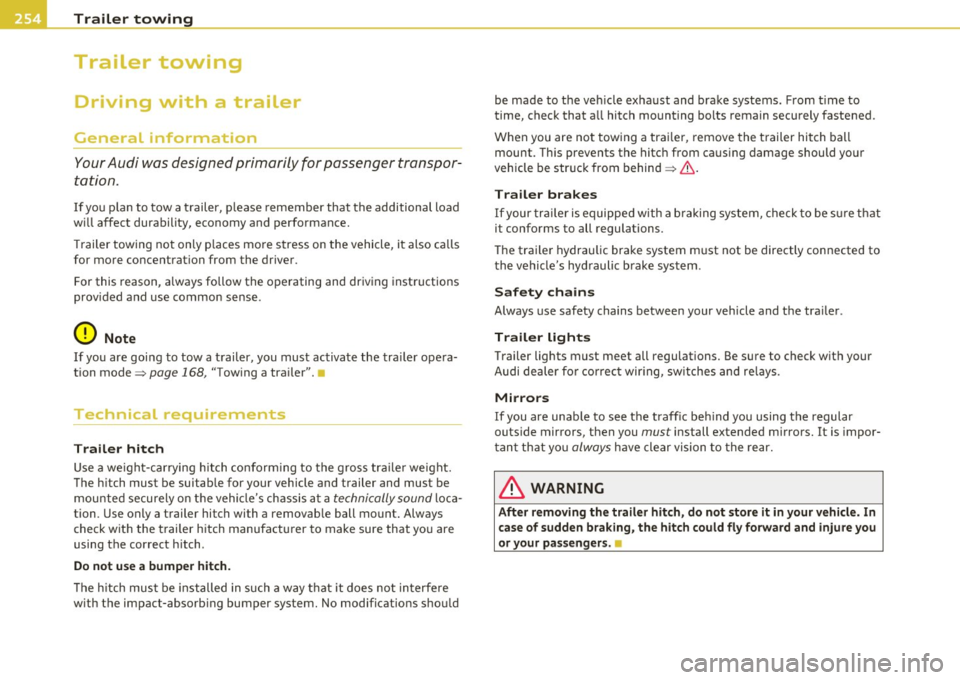
Trailer towing
"---------------------------------------------------
Trailer towing
Driving with a trailer
General information
Your Audi was designed primarily for passenger transpor
tation .
If you p lan to tow a t railer, p lease remember that the additional load
w ill affect durability, economy and performance.
Tr ailer towing not on ly p laces mo re s tress on the vehicle, it also calls
for more concentration from the driver.
For this reason, a lways follow the operating and dr iv ing inst ructions
prov ided and use common sense .
0 Note
If you are going to tow a trailer, you must activate the tra iler ope ra
tion mode =>
page 168, "Towing a tra iler". •
Technical requirements
Trailer hitch
Use a we igh t-car rying h itch co nform ing to the gross tra iler we ig ht.
The h itch must be suitab le for your vehicle and trailer and must be
mou nted securely o n th e vehi cle's ch assi s at a
techni cally sound loc a
tion . Use only a trailer hitch with a removab le ball mount. Always
check wit h the t railer h itch manufactu rer to make sure that yo u are
using the correct h itch .
Do not use a bumper hitch.
The h itch mus t be installed in such a way t hat it does not in terfe re
w ith t he impact-absorb ing bumper system. No modifications shou ld be made to t
he veh icle exha ust and bra ke systems. From t ime to
time, check that a ll hitch mounting bo lts rema in securely fastened.
W hen you are no t tow in g a tra ile r, remove the t railer hit ch ball
mount. This prevents the hitc h from caus ing damage should your
vehicle be str uck from behind=>& .
Trailer brakes
If your trail er is e quipped w ith a b raking system, che ck to be s ure t hat
it conforms to all regulations.
T he tra ile r hydrau lic brake system m ust not be directly connected to
t he vehicle's hyd raulic b rake sys tem .
Safety chains
Always use safety chains between your veh icle and t he tra ile r.
Trailer lights
Trailer lights must meet all regulations. Be sure to check w ith your
Audi de aler fo r corr ec t wir ing , sw itches and re lays.
Mirrors
If you are unab le to see t he t raff ic be hind you using t he regular
outs ide mirrors, then you
must install extended mi rrors. It is impor
t an t th at yo u
always ha ve clear vi sion to the re ar.
& WARNING
After removing the trailer hitch, do not store it in your vehicle. In
case of sudden braking , the hitch could fly forward and inju re you
or your passengers. •
Page 257 of 368
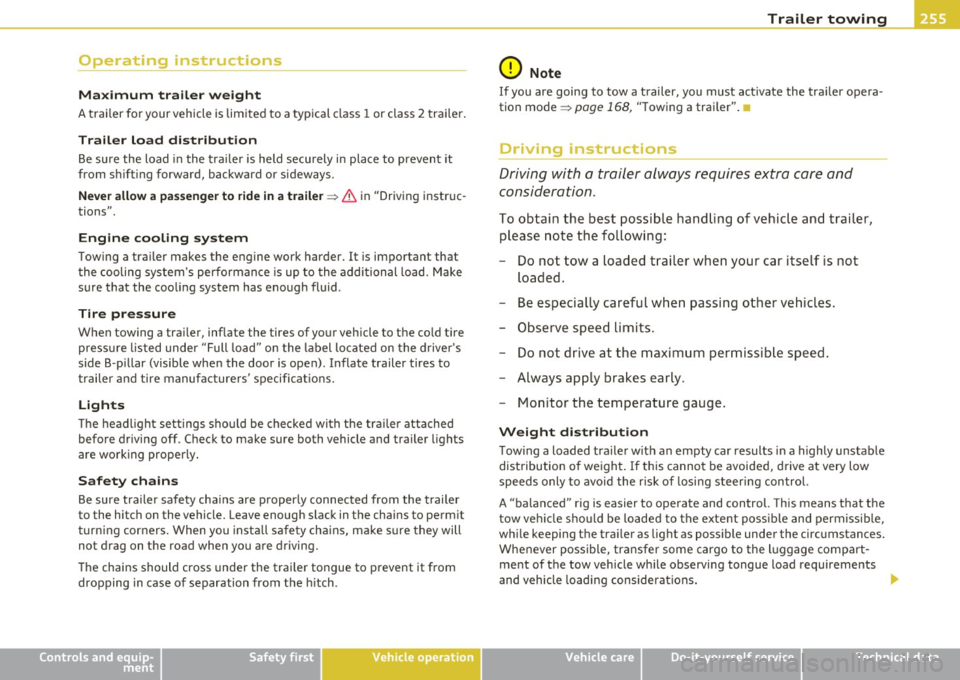
Operating instructions
Max imum tr aile r weight
A trai ler for your vehicle is lim ited to a typical class 1 or class 2 trailer.
Trail er lo ad di stribut ion
Be sure the load in the t ra iler is held secu rely in place to prevent it
from shift ing forward, backward or sideways.
N ev er a llow a pa ssenge r to ride in a traile r=>
& in "Driving instr uc
tions".
Eng ine c ooling s ystem
Towing a trailer makes the eng ine work harder. It is important that
the cooling system 's performance is up to the addi tional load. Make
sure that the cooling system has enough fluid.
Tire pre ssur e
When towing a tra iler, inflate the tires of your veh icle to the co ld tire
pressu re listed under "Full load" on the label located on the d river's
side 8 -pillar (visible when the door is open) . Inflate traile r tires to
t rai ler and tire manufacture rs' specificat io n s.
Light s
The headl ight sett ings shou ld be checked with the tr ailer attached
before driving off. Check to make sure both vehicle and trailer lights
are working properly .
Safety chain s
Be sure traile r safety cha ins are p roperly connected from the trai ler
to the hitch on the vehicle. Leave enough slack in the chains to perm it
tu rning corners. When you install sa fe ty cha ins, make s ure they will
not drag on the road when you are driving.
T he chains should cross under the trai ler tongue to prevent it from
dropping in case of separation from the h itch .
Controls and equip ment Safety first Vehicle operation
0 Note
If you are going to tow a t
railer, you must activate the tra iler opera
tion mode =>
page 168, "T owing a trai ler" .
Driving instructions
Driving with a trailer always requires e xtra care and
consideration .
To obtain the best possible handling of vehic le and trailer,
please note the following:
- Do not tow a loaded trailer when your car itself is not
loaded.
- Be especially careful when passing other veh icles .
- Observe speed limits .
- Do not dr ive at the maximum permissible speed.
- Always apply brakes early .
- Monitor the temperature gauge .
Weight distribut ion
T owing a loaded tra iler w ith an empty car results in a highly unstable
distribution of we ight . If this cannot be avoided, d rive at very low
speeds only to avoid the risk of losing steering control.
A "balanced" r ig is easier to operate and control. This means that the
t ow ve hicle sho uld be loaded to the exte nt poss ible and permissib le,
wh ile keeping the tra iler as light as poss ible under the circumstances.
Whenever poss ible, tra nsfer some cargo to the l uggage compart
ment of the tow vehicle while observing tongue load requirements
and vehicle load ing considerations .
Vehicle care Do-it-yourself service Technical data
Page 262 of 368
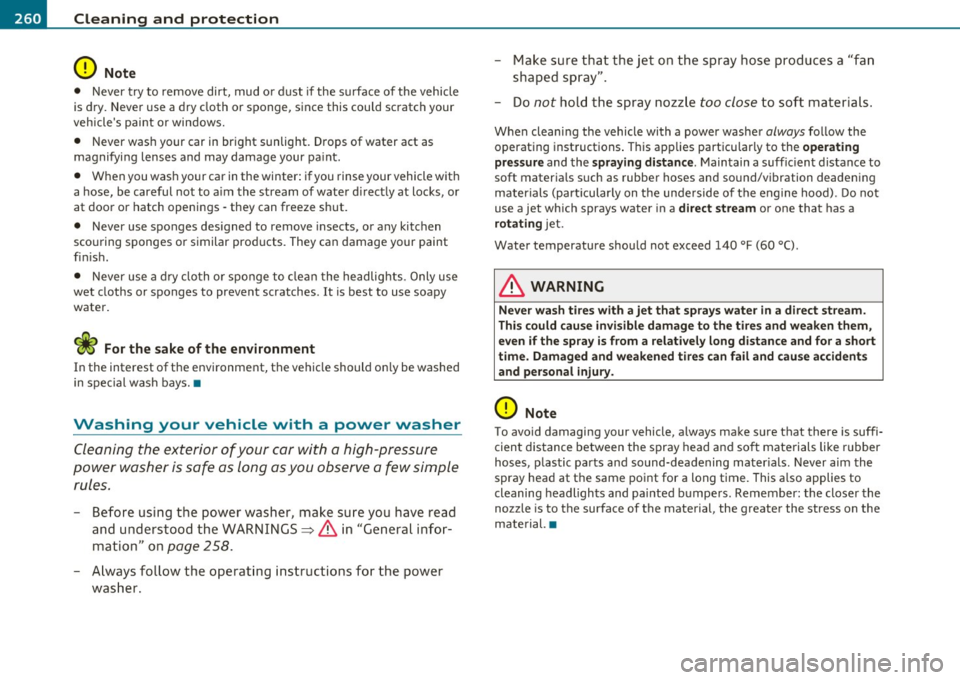
-~_C_ le_ a_n_ i_ n_ g=- a_ n_d___. p_ ro_ t_e _c_ t_ i_o _n ___________________________________________ _
0 Note
• Never try to remove dirt, mud or dust if the surface of the vehicle
is dry. Never use a dry cloth or sponge, since this could scratch your
vehicle's paint or windows.
• Never wash your car in bright sunlight . Drops of water act as
magnifying lenses and may damage your pa int.
• When you wash your car in the winter: if you rinse your vehicle with
a hose, be careful not to a im the stream of water d irectly at locks, or
at door or hatch openings -they can freeze shut.
• Never use sponges designed to remove insects, or any kitchen
scouring sponges or similar products. They can damage your paint
fin ish .
• Never use a dry cloth or sponge to clean the headlights . Only use
wet cloths or sponges to prevent scratches . It is best to use soapy
water.
For the sake of the environment
In the interest of the environment, the vehicle should on ly be washed
in special wash bays. •
Washing your vehicle with a power washer
Cleaning the exterior of your car with a high-pressure
power washer is safe as long as you observe a few simple
rules .
-Before using the power washer, make sure you have read
and unders tood the WARNINGS ~
& in "General infor
mation" on
page 258.
- Always follow the operating instructions for the power
washer. -
Make sure that the jet on the spray hose produces a "fan
shaped spray".
- Do
not hold the spray nozzle too close to soft materials.
When cleaning the vehicle with a power washer always follow the
operating instructions. This applies particularly to the
operating
pressure
and the spraying distance. Maintain a sufficient distance to
soft materials such as rubber hoses and sound/vibration deadening
materials (particularly on the underside of the engine hood). Do not
use a jet which sprays water in a
direct stream or one that has a
rotating jet.
Water temperature should not exceed 140
°F (60 °() .
& WARNING
Never wash tires with a jet that sprays water in a direct stream.
This could cause invisible damage to the tires and weaken them,
even if the spray is from a relatively long distance and for a short
time. Damaged and weakened tires can fail and cause accidents
and personal injury .
0 Note
To avoid damaging your vehicle, always make sure that there is suffi
cient distance between the spray head and soft materials like rubber
hoses , plastic parts and sound-deadening mater ials. Never aim the
spray head at the same point for a long time. This a lso applies to
cleaning headlights and painted bumpers. Remember: the closer the
nozzle is to the surface of the material, the greater the stress on the
material. •
Page 282 of 368

___ C_ h_e _c_ k_ i_ n _ g_ a_ n _ d_ f_il _l _in ____ g ___________________________________________ _
Changing the engine oil
The engine oil and oil fi lter must be changed according to the mileage
(kilometers) and t ime intervals specified in your vehicle 's Warranty
&
Maintenance booklet . Do not exceed these interva ls -harmful
deposits from o ld engine oil can reduce engine performance and can
lead to expensive engine repairs .
Changing the oil at the recommended intervals is so very impo rtant
because the lubricating properties of o il decrease gradually during
normal vehicle use. If you are not sure when you have your oil
changed, ask your author ized Audi Service Adv isor .
Under some circumstances the engine oil should even be changed
mo re frequently. Change oil more often if you drive mostly short
distances, operate the vehicle in dusty areas or mostly under stop
and-go traffic conditions, or when you use your vehicle where temper
atures stay be low freezing point for long periods.
Detergent addit ives in the oi l wi ll make fresh oil look dark after the
engine has been running for a short t ime. This is normal and is not a
reason to change the oil more often than recommended .
Damage or malfunctions due to lack of maintenance
It is essential that you change your oil at the recommended intervals
using only engine oi l that complies with Audi oil standard
VW 502 00. Your Limited New Vehicle War ranty does not cover
damage or malfunctions due to fai lure to follow recommended main
tenance and use requirements as set forth in the Audi Owner 's
Manual and Warranty
& Maintenance booklet. Your dealer will have
to deny warranty coverage unless you present to the dealer proof in
the form of Serv ice or Repair Orders that all scheduled maintenance
was performed in a time ly manner. •
Engine oil consumption
The engine in your vehicle depends on an adequate
amount of oil to lubricate and cool all of its moving parts.
In order to provide effective lubrication and cooling of internal
eng ine components, all inte rnal combustion engines consume a
certain amount of oil. Oil consumption varies from engine to engine
and may change sign ifican tly over the lif e of the engine. Typically,
engines with a specified break- in period (see~
page 249) consume
more oil during the break-in period than they consume after oil
consumption has stab ilized .
Under normal conditions, the rate of oil consumption depends on the
quality and viscosity of the oil, the RPM (revolutions per minute) at
which the engine is operated, the ambient temperature and road
conditions. Further factors are the amount of oil dilution from water
condensation or fuel residue and the ox idation level of the oil. As any
eng ine is subject to wear as mileage builds up, the oil consumption
may increase over time until replacement of worn components may
become necessary.
With all these variab les coming into play, no standard rate of oil
consumption can be established or specified . There is no alternative
to regular and frequent checking of the oil level , see
Note .
If the yellow engine oil leve l warning symbol in the instrument
cl uster lights up, you should chec k the oil level as soon as possible
with the oil dipstick~ page 281. Top off the oil at your earliest
convenience ~
page 282.
& WARNING
Before you check anything in the engine compartment, always
read and heed all WARNINGS~
& in "Working in the engine
compartment" on
page 277.
Page 290 of 368

-L~C~ h~ e~c ~k :..!_i ~ n ~g ~ a~n ~d~ f~il ~l~in ~ g[_ ________________________________________ _
0 Note
Brake fluid will damage the paint of your vehicle.
the special tools required and the necessary expertise, we recom
mend that you have the brake fluid changed by your authorized Audi
dealer. •
Battery
General information
Under normal operating condit ions, the battery in your Aud i does not
need any maintenance. With
high outside temperatures or long daily
drives we recommend that you have the electrolyte level checked by
a service facility. The electrolyte level should also be checked each
time the battery is charged~
page 290.
Have the battery checked when you take your vehicle in for service.
You are well advised to replace a battery that is older than 5 years.
With certain types of a irbag deployment, the battery is disconnected
from the vehicle electrical system for safety reasons=>
& in "Repair,
care and disposal of the airbags" on
page 209.
Disconnecting the battery terminals
Some vehicle functions (power window regulators, for example) are
lost if the battery terminals are disconnected. These functions have
to be relearned after the battery terminals are connected aga in. To
prevent this, the battery should only be disconnected from the
vehicle electrical system when absolutely necessary for repairs.
Vehicles not driven for long periods
If you do not drive your veh icle over a period of severa l days or weeks,
electrical components are gradually cut back or switched off. This
reduces energy consumption and maintains starting capability over a
longer period~
page 247.
Take into consideration that when you unlock your vehicle, some
convenience functions, such as the master key remote function or
power seat adjustment, may not be available. The convenience func
tions will be available again when you turn on the ign ition and start
the engine.
Winter operation
During the winter months, battery capacity tends to decrease as
temperatures drop. This is because more power is also consumed
while starting, and the headlights, rear window defogger, etc., are used more often .
Avoid unnecessary power consumpt ion, particu larly in city traffic or
when traveling only short distances. Let your authorized Audi dealer
check the capacity of the vehicle battery before w inter sets in
=> page 290. A well charged battery will not only prevent starting
problems when the weather is cold, but will also last longe r.
(I] Tips
If your veh icle is left standing for several weeks at extreme ly low
temperatures, the vehicle battery should be removed and stored
where it will not freeze. This will prevent it from being damaged and
having to be replaced.•
Page 329 of 368

______________________________________________ F _u_s _e_ s_ a_ n_ d _ b _u_l_b _ s _ ___.9I
No. Equipment
29 Not used
30 Not used
31 Back-up
light switch, transmission, engine com-
ponents
Intelligent power module driver (footwell light
32 and front headlights, horn, wiper system, elec-
trically adjustable steering wheel)
-
33 Intelligent power module dr
iver
(lights left-side)
34 Intelligent power module driver
(lights right-side)
35 Not used
36 Headlight
washer system
37 Electronic Stabilization Program (ESP)
38 Wiper system
39 Door control module
left-side
Horn
41 Heater fan
42 Control module electronic ignition lock/electri-
cally adjustable steering wheel
43 Rear
windshie ld wiper (Avant)
44 Power window opener (left-side)
Amps
15
30
25
25
30
25
30 15
25
40
30
15
-
-
35 •
Vehicle OP-eration
Fuse Location, Instrument Panel right
Fig. 236 Fuse panel
l ayou t
Some of the equipment items listed are optional or only available on
certain model configurations.
Note that the following table is accurate at the time of going to
press and is subject to change. In the event of discrepancies, the
label on the inside of the cover always takes precedence.
The power seats are protected by circuit breakers , which automati
cally reset afte r a few seconds after the overload has been remedied.
No. Equipment Amps
Fuse holder (black)
1 Control module Convenience
key
15
2 Cigarette lighter front 20
3 Tire pressure monitoring system
5
4 Electrical outlet front (center console)
20
-
5 Intelligent power module passenger
15
(glove box lock)
6 Door control module right-s ide
15
Sunroof 20
A/C controls 10
Vehicle care Do-it-yourself service iTechnical data
Page 330 of 368
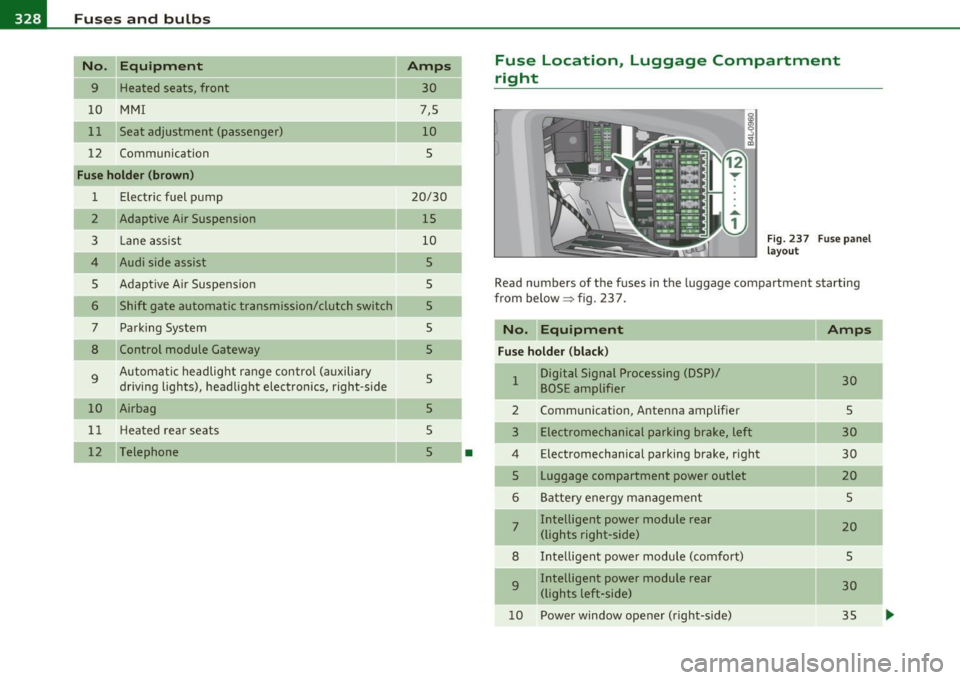
.,.,___F_ u_ s_e _ s_ a_n_ d_ b_u _ l_ b_ s _______________________________________________ _
No. Equipment Amps
9 Heated seats, front 30
10 MMI
7,5
11 Seat adjustment (passenger) 10
12 Communication 5
Fuse holder (brown)
1 Electric fuel pump 20/30
2 Adaptive Air Suspension
15
3 Lane assist 10
4 Audi side assist
5
5 Adaptive Air Suspension 5
6 Shift gate automatic transmission/clutch switch 5
7 Parking System 5
8 Control module Gateway 5
9
Automatic headlight range control (auxiliary 5
driving lights), headlight electronics, right-side
10 Airbag 5
11 Heated rear seats 5
12 Telephone
5 •
Fuse Location, Luggage Compartment
right
Fig. 237 Fuse panel
layout
Read numbers of the fuses in the luggage compartment starting
from below :::::> fig. 23 7.
No. Equipment
Amps
Fuse holder (black)
1 Digital Signal Processing (DSP)/ 30 BOSE amplifier
2 Communication, Antenna amplifier 5
3 Electromechanical parking brake, left 30
4 Electromechanical parking brake, right
30
5 Luggage compartment power outlet
20
6 Battery energy management 5
7 Intelligent power module rear
20 (lights right-side)
8 Intelligent power module (comfort)
5
9 Intelligent power module rear
30
(lights left-side)
10 Power window opener (right-side)
35
-
-
-
...
Page 331 of 368
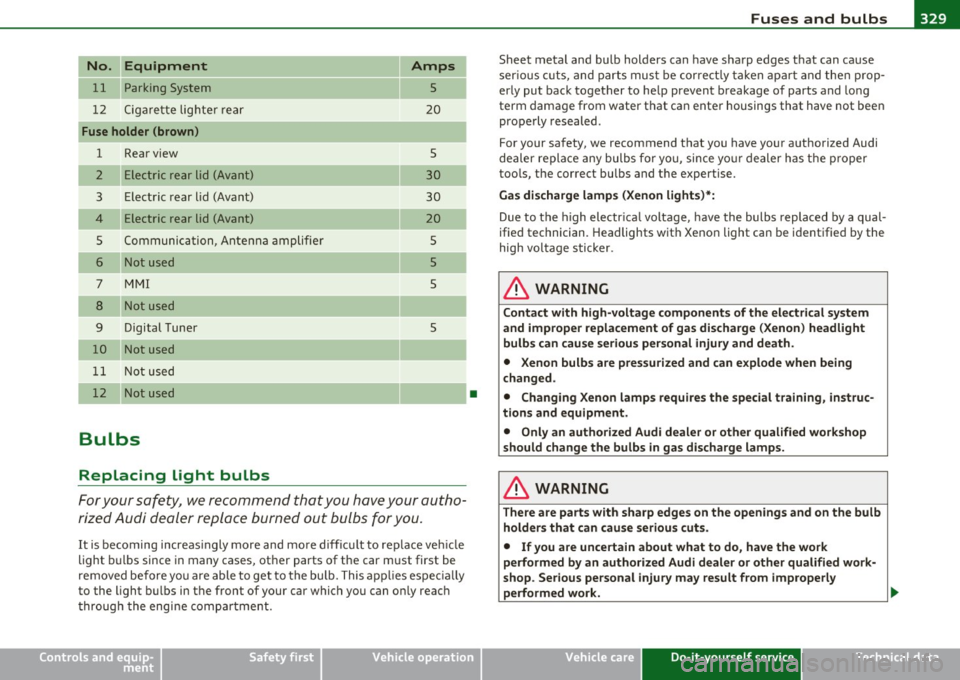
_______________________________________________ F_u _s_ e_ s_ a_ n_ d_ b_u _ l_ b _ s __ _
No. Equipment
11 Pa rk in g System
12 Cigare tt e lig ht er r ea r
Fuse holder (brown)
1 Rear view
2 El ectr ic re ar lid (A va nt)
3 Electric rear lid (Avant)
4 Electric rear lid (Avant)
5 Co mmuni cation, An te n na amplifie r
6 Not used
7 M MI
8 Not used
9 Digital Tuner
10 Not used
11 Not used
12 No t used
Bulbs
Replacing Light bulbs
Amps
5
20
5
30
30
20
5
5
5
5
For your safety, we recommend that you have your autho
rized Audi dealer replace burned out bulbs for you.
It is becoming increas ingly more and mo re difficu lt to replace veh icle
light b ulbs since in many cases, other parts of t he car must first be
removed before yo u are able to get to the bu lb. This ap plies espe cially
to the light bu lbs in the front of your car which you can on ly reach
through the engi ne compa rtment.
Safety first
•
Sheet metal and bulb holders can have sharp edges that can cause
ser io us c uts, and parts mus t be cor re ct ly ta ken apar t and the n prop
erly put back together to he lp prevent breakage of parts and long
term damage from water t hat ca n enter housings that have not been
properly resealed .
For your safety, we recommend that you have your a uthorized Audi
dealer replace any bulbs fo r yo u, since yo ur dealer has t he pr oper
too ls, the correct bu lbs and t he expertise.
Gas discharge lamp s (Xenon lights) *:
Due to the high electr ica l voltage, have the bulbs replaced by a qual
ified technician. Headlights with Xenon light can be identified by the
high vol tage s ticker.
& WARNING
Contact with high-voltage components of the electrical system
and improper repla cement of g as discharge (Xenon ) headlight
bulb s can cause serious personal injury and dea th .
• Xenon bulbs are pres surized and can e xplode when being
c hanged.
• Changing Xenon lamp s requires the special training , instruc
tions and equipm ent .
• Only an authorized Audi dealer
or oth er qualified work shop
should change the bulbs in gas discharge lamps .
& WARNING
There are parts with sharp edge s on the opening s and on the bulb
holder s that can cau se serious cuts.
• If you are unce rtain about what to do, have the work
performed by an authorized Audi dealer or other qualified work
shop . Se rious personal injury m ay result from improperly
performed work. ..
Vehicle care Do-it-yourself service Technical data